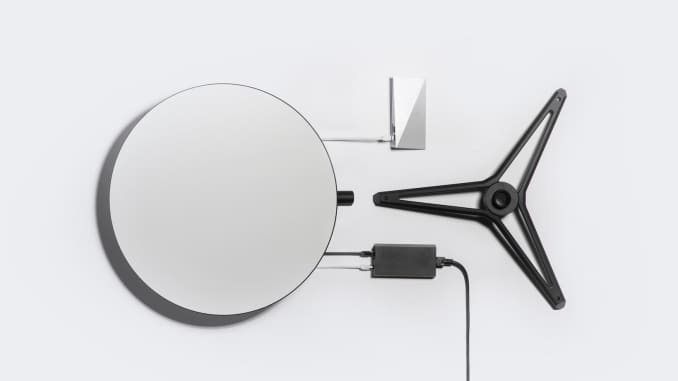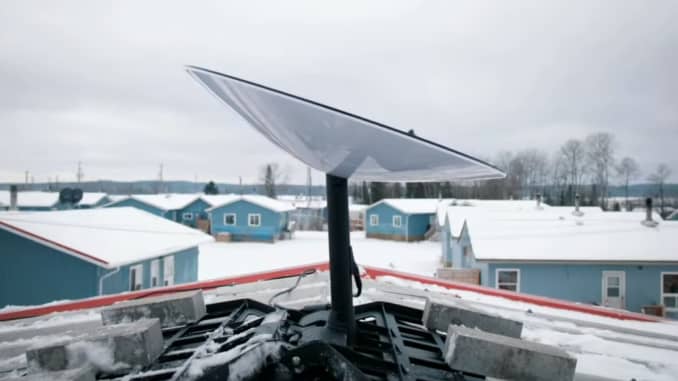Elon Musk’s SpaceX rolled out its Starlink early access program to the public six months ago, with the satellite internet service growing to more than 10,000 users in the first few months.
To get real-life first impressions of the service, CNBC spoke to more than 50 people who have been using Starlink. Those surveyed included households in Canada and 13 U.S. states: California, Colorado, Idaho, Iowa, Maine, Michigan, Minnesota, Montana, Ohio, Oregon, Washington, Wisconsin and Wyoming.
The majority of these Starlink users are in rural or remote areas, such as farmland or wilderness, with limited access to terrestrial broadband options – and a few with no access altogether.
“I expect to keep the service long term,” a user in Montana told CNBC. “The price of the beta for the service is more reasonable than any other option we have, and those are worse in performance. I will keep Starlink as long as its the only broadband option available to me.”

Starlink is the company’s capital-intensive project to build an interconnected internet network with thousands of satellites, known in the space industry as a constellation, designed to deliver high-speed internet to consumers anywhere on the planet.
SpaceX launched the “Better than Nothing Beta” program for the public in October, and the majority of users CNBC surveyed received invitations to join between November and February. The service is priced at $99 a month in the U.S. under the beta, with a $499 upfront cost for the equipment customers need to connect to the satellites – plus taxes, shipping, and any accessories needed to mount the antenna.
CNBC’s surveyed users on total cost, the installation process, what they thought of SpaceX’s equipment, internet speed, reliability of the service, what their service alternatives were, their experience with customer service, any concerns they had, and their overall impressions. Here’s what users said.
Pricing

SpaceX priced the user equipment well below its actual cost, with the company currently absorbing about two-thirds of the cost of the customer equipment.
Users’ upfront costs ranged from $550 to as much as $800 – varying based on taxes, shipping costs, and additional equipment needed such as roof mounts or third-party items for installation.
Most users found the services monthly price of $99 to be fair, and oftentimes a discount to other satellite broadband services and terrestrial options – especially given the average speed of Starlink’s service. SpaceX president Gwynne Shotwell last week said the company does not plan to add “tiered pricing to consumers,” emphasizing that it wants “to try to keep it as simple as possible and transparent as possible.”
Equipment

The “Starlink Kit” that is sent to customers includes four significant parts: The user terminal (also known as the antenna), a tripod mount, a Wi-Fi router, and a power supply. SpaceX also offers rooftop mounting options for an additional cost.
Users were largely impressed with quality of the equipment, especially the antenna – which is nicknamed “Dishy McFlatface” in the SpaceX guide.
“Barring a massive hailstorm, I don’t see much hurting this thing at all,” one user said.
A handful of users were disappointed in the quality of SpaceX’s supplied Wi-Fi router, with several choosing to go with third-party router options. A Montana user described it as “a brick with a wifi signal,” noting that it is quick to setup but lacks configuration options aside from setting the network’s password.
“I opted to use my own router and plugged directly into the port their router would have been connected to,” the Montana-based user said.
Installation

The installation process delivered the widest range of user opinions, as some – mostly those who have performed rooftop equipment installations before – found it a very easy process while others had to spend hours to get the antenna working.
“The hardest part was getting up on the roof, mounting the dish and running the wire from the outside to the inside of the house,” a Colorado user said.
Obstructions to the antenna’s view of the sky, and therefore connection to overhead satellites, was the most frequent issue for users installing the dish. A mobile application for Starlink users includes an augmented reality feature to check for obstructions and help find the right place to install the antenna.
“My trees are really tall and I underestimated the need for the Starlink’s obstruction-detecting app to really show 0 trees,” a user in Oregon said.
Internet speed

SpaceX told the Federal Communications Commission in February that Starlink’s internet service is “exceeding” 100 megabits per second download speeds, 20 megabits per second upload speeds, and latency “at or below 31 milliseconds.” Latency is the amount of delay in an internet network, defining how much time it takes a signal to travel back and forth from a destination. Latency and download speeds are key measures for an internet service provider.
The company’s report to the FCC matched with what users told CNBC, who reported download speeds ranging between 60 Mbps to 150 mbps – with some even reporting peak speeds near 200. Latency also matched expectations, as most users reported latency of about 30 milliseconds – with some in the low 20 milliseconds.
Musk promised earlier this year that Starlink’s performance will continue to improve as the company launches more satellites, saying “speed will double” to about 300 Mbps later this year and latency will be more consistently in the 20 millisecond range.
SpaceX has warned that users would experience drops in service during the beta, given it does not yet have its full satellite fleet in orbit. In a 24 hour period, most users saw a handful of downtimes between three and five minutes. Sometimes downtimes were as short as 20 seconds, while a few users reported downtimes between 10 and 20 minutes. The Starlink application also gives users a countdown to when the next satellite is expected to reconnect service.
“The service is quite reliable, there are a few outages once in a while,” a Maine user said. “We mostly use it to watch Netflix, Hulu, and Youtube. We do a bit of gaming as well on the system with no issues.”
Users who spoke to CNBC said they use multiple devices without any impact on the service’s quality or speed.
“We are online all day, every day on meetings. It sustains that easily. We also use streaming services. Combined with my in-laws, we have at least 25 devices (smart phones, laptops, desktops, iPads, smart tv, smart home devices, etc.,),” a user in Minnesota said.
In addition to the reliability of the internet service itself, users said the Starlink equipment has held up well in the elements. Users reported the Starlink antenna continuing to work in the midst of heavy winds, rainfall, and snowstorms. Additionally, as some users’ remote locations require they pay close attention to power consumption, the equipment does not draw too much power, with a user in California saying that “it’s about the same consumption as the flood light bulb that lights our driveway.”
What they switched from
Users reported a wide variety of prior services that they had before Starlink, ranging from other satellite broadband companies to low-speed wired networks to cellular hotspots – and some with no prior service at all.
Starlink users most commonly switched for one of three reasons: Price, speed and data restrictions (also known as “caps”). A user in Ohio said they paid $180 per month to a local service provider that advertised faster speeds, but found Starlink to be faster on average. A California user previously had satellite service they said “was slightly more reliable” in terms of outages, but download speeds were 1 Mbps with a latency of around 1000 milliseconds.
“I keep asking my local [telecommunications technicians] if fiber will ever roll out in my town, and they say ‘5 years to never’ each time,” a Montana user said.
A user in Canada said their area has two local “high speed” internet service providers but that the cost was far too high by comparison.
“Both require substantial investment in hardware (towers, dishes, etc), have pretty restrictive data-caps and do not guarantee speeds. In short, they are s--t,” the Canadian user said.
Customer service

SpaceX’s core business to date has been launching rockets, so the customer service aspect of becoming an internet service provider is new to the company. Only a handful of users had reached out about issues, but each were happy with how SpaceX responded.
One user in Oregon said they were “unable to connect initially” when setting up their Starlink service.
“I opened a support case and they responded, and then called me, within a few hours. They had to adjust something on their end, and the issue was resolved that afternoon,” the user said.
Another user in Minnesota said “support responses have been great,” noting that “usually within 1-2 hours I’ll hear back from someone” at SpaceX.
Concerns
The biggest concern voiced by those surveyed centered around the possibility of SpaceX introducing data restrictions in the future. A few expect restrictions to be inevitable, and one user said they “will immediately be cancelling service without hesitation if there are any data caps.”
Asked what restrictions they’d find acceptable, users said they would be satisfied with data caps between 750 gigabytes to 1 terabyte per month.
The installation process, and the apparent “lacking of grounding for lightning” in the equipment, was a concern for a California user.
“Running the cable into the house probably won’t be easy for the general public,” the user said.
That user said they had not integrated the Starlink equipment into their home network due to the grounding concern, saying “I don’t want an errant strike to blow up all my network gear and server.”
“I’d like to think that SpaceX has thought about that but it doesn’t seem to be called out in documentation anywhere, so to minimize the risk I’m keeping everything separate for now,” the California user said.
Overall

Starlink users were fairly ecstatic in their overall impressions with the service, with nearly all expecting to keep it long-term.
“The experience has been great, support from Starlink has been awesome, and updates keep getting pushed to the Starlink app,” a Maine user said. “I’m extremely happy with everything.”
Users also emphasized a key point that SpaceX itself has said, which is that the service is a boon for those in rural areas but not a replacement for the existing internet service of people in cities.
“This a game changer for rural America,” a Montana user said. “I think there is a lot of people who now have options to work remotely due to the pandemic that will utilize this service.”
While SpaceX has begun accepting pre-orders for service, with more southern parts of the U.S. expected to get access in the year ahead, the company does not yet have a timeframe for when Starlink will exit the beta phase and begin full commercial service. SpaceX’s Shotwell said earlier this month that the company has “a lot of work to do to make the network reliable,” a fact emphasized by a user in Wyoming.
“Be prepared - it’s beta. Outages are to be expected, tech support may be slow. This is not meant for consumers wanting to do full production without interruption or delayed support,” the Wyoming user said.
For now, even with Starlink’s limitations, many users are simply excited to have access to a new high-speed service.
“I’m downright giddy to have real internet after living without for 14 years,” an Oregon user said. “I can just watch a show, without worrying about whether I’ll hit my bandwidth cap. I can download a new game when I want to, instead of having to take my laptop to a friend’s house. It’s a bit of a lifestyle change.”